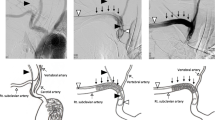Abstract
Central venous catheters that have been in place for a long time can become fixed to the vein wall, making them impossible to pull out. Leaving them in situ is undesirable because of the risk that they could act as a nidus for thrombosis. Moreover, inserting new catheters alongside the old ones might compromise flow in the superior vena cava, further predisposing to thrombosis. Surgical removal is likewise undesirable, as this would necessitate thoracotomy with the attendant risks. We describe a novel technique, which we were able to use to remove retained long-term hemodialysis catheters in a patient who needed new catheters and who would have been a high-risk candidate for surgery. The right internal jugular vein was punctured adjacent to the site of insertion and a guide wire was used to form a snare, which was passed around the catheters and used to saw through the fibrous attachments to the vein wall. The midsection of one catheter could not be freed but the snare was used to cut off the proximal and distal ends, which could then be removed, the latter via the femoral vein. New catheters were then inserted via the left internal jugular vein. This technique enabled successful catheter extraction and replacement in a patient who would have been a poor candidate for cardiothoracic surgery.



Similar content being viewed by others
References
Bessoud B, de Baere T, Kuoch V, et al. (2003) Experience at a single institution with endovascular treatment of mechanical complications caused by implanted central venous access devices in pediatric and adult patients. Am J Roentgenol 180(2):527–532
Gabelmann A, Kramer SC, Tomczak R, et al. (2001) Percutaneous techniques for managing maldeployed or migrated stents. Endovasc Ther 8(3):291–302
Fuenfer MM, Georgeson KE, Cain WS, et al. (1998). Etiology and retrieval of retained central venous catheter fragments within the heart and great vessels of infants and children. J Pediatr Surg 33(3):454–456
Andrews RE, Tulloh RM, Rigby ML (2002) Percutaneous retrieval of central venous catheter fragments. Arch Dis Child 87(2):149–150
Jones SA, Giacomantonio MJ (2003) A complication associated with central line removal in the pediatric population: retained fixed catheter fragments. Pediatr Surg 38(4):594–596
Kanada DJ, Jung RC, Ishihara S (1979) Superior vena cava syndrome due to a retained central venous pressure catheter. Chest 75(6):734–735
Author information
Authors and Affiliations
Corresponding author
Rights and permissions
About this article
Cite this article
Foley, P.T., Carter, R.M. & Uberoi, R. Endovascular Removal of Long-Term Hemodialysis Catheters. Cardiovasc Intervent Radiol 30, 1079–1081 (2007). https://doi.org/10.1007/s00270-007-9018-5
Published:
Issue Date:
DOI: https://doi.org/10.1007/s00270-007-9018-5




